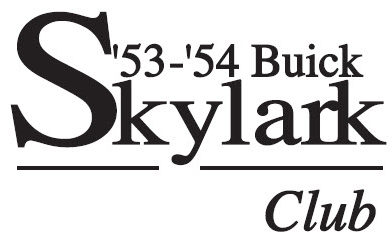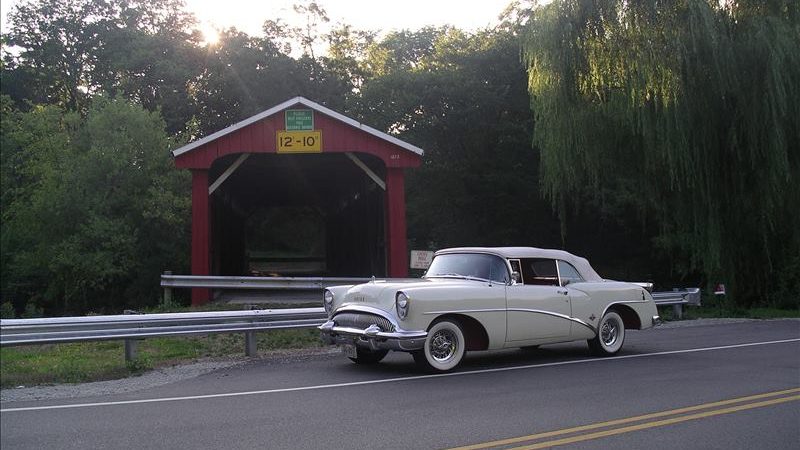500 MILES WEST OF FLINT
by: Al ‘Junior’ Malachowski
Hey Sven, duz dat Teal Blue fifty-tree Lark stop anyting bedder ven de enyun goes kapuut after youse brot dat inta da fixer-uuper shop? No such luuke, Ole. After dem guys vorked and vorked on dat contraption unda da floor, dey give up and yust made dee horn toot a yiddle yowder.
UFF DA! It sounds to me like Sven’s power brake system might be missing a few parts and his mechanics are looking in the wrong location for an answer. Given that his problem happens only when the engine stalls on his original early-1953 Skylark (Teal Blue was discontinued in May, 1953), the power brake system auxiliary electric vacuum pump (EVP) and its relay might be the answer to solving his hard brake-pedal problem. Together with an operational OE power brake cylinder (PBC), the EVP should provide a soft pedal and good brakes when the engine stalls, contrary to an alternative fact that appeared in the August 2012 Skylark Club Newsletter addressing the troublesome 1953 PBC…the original unit in your Skylark does not work if your car stops running (you will have no brakes).
The EVP was a factory-installed item on all 1953 Buicks with the power brake option built during the last month of the production run, beginning with Car Serial Number 17150754, on Skylarks with a body production number of ± 1679-1690, and on all 1954 Buicks likewise equipped. The intent of the EVP was to start running and provide adequate vacuum to attain a soft pedal for the power brake system only when the ignition key is turned to the ON position and when the generator doesn’t generate sufficient voltage to turn the pump off, which according to Buick specifications, is an engine speed of ± 250 RPM compared to a normal idle speed of ± 450 RPM. Once the required RPM are reached, the relay cuts-out and stops the EVP from running and the engine’s manifold vacuum takes over.
Missing and considering installing one for added assurance? Working OE parts are somewhat hard to find but here is what’s out there for literature. Since the rushed-into-production Buick power brake system wasn’t introduced until 1953 B.C. (before Cadillac), and the EVP came out in late-1953, both after the 1952 AND SUPPLEMENTARY-1953 BUICK SHOP MANUALS were already published, you’re out of luck if your reference library is limited to these two manuals. A better source would be to find a 1953 BUICK PRODUCT SERVICE BULLETINS, Abridged Edition, or the October 15th BUICK BULLETIN 2.353, that has the information on how the TRICO EVP should work, pictures of a completed installation, limited instructions, and a wiring diagram. Reference is also made to a template with all the dimensions, CHART 53-730, that is included in a TRICO ELECTRO-VAC installation kit, Group 4.899, Part 1391768, pictured below. The suggested location is under the hood, on the rear face of the sloped driver’s side front fender skirt (inner fender), in a triangular depression below the fresh air intake opening. A flat-rate installation time was noted at 1.0 hour. Good luck on the one hour without a lift.

Being that all 1954 Buicks with power brakes came standard from the factory with the EVP, the 1954 BUICK SHOP MANUAL includes servicing information, exploded-view comparison pictures of the newer MORVAC (built by Moraine Products Division) and the original TRICO ELECTRO-VAC EVPs, adjustment specifications for the cut-out relay, and a more-detailed wiring circuit diagram (Figure 10-95). Information on the differing mounting brackets and a layout template for the MORVAC EVP is not included. It does note that an EVP can supply 10” (Hg) of vacuum to the PBC in two seconds once the ignition is turned to the ON position with a maximum output of 20” (Hg). A BUICK MASTER CHASSIS PARTS BOOK covering the 1953-1954 years has comparison drawings of the two different pumps, motors, mounting brackets, hardware, and all the parts numbers.
The 1954 BUICK PRODUCT SERVICE BULLETINS, Abridged Edition, addresses customer’s complaints and situations to avoid: internally-grounded EVPs that shorted out; sealing the EVP’s motor wires from moisture penetration with a body calk (Permagum); removing the EVP’s inline fuse whenever you’re troubleshooting other electrical problems for an extended period of time with the ignition key turned to the ON position and the engine’s not running, to prevent burning out the motor; and running the pump dry without the special PBC 5W oil. Installation time was now bumped up to 1.5 hours to complete the following work: disconnecting or removing/replacing the battery cable, LF wheel, starter splash pan, fresh air intake hose, and the ignition’s anti-theft plate; drilling the five mounting holes from the wheel-well side; installing the EVP and relay; rerouting the 11/32” vacuum hoses; and tying-in all the wires. Don’t put the tools away yet. Take her out for a test run on a quiet backroad stretch and while free-rolling at a good clip, turn the ignition to the OFF position and then after a few seconds later, turn it back to the ON position and listen for the EVP to start running. With everything wired and working correctly, you should have soft brake pedal-pumps to get da Lark to a complete stop and then some, until you turn the ignition back to the OFF position.
Starting in 1955, Buick abandoned the EVP and went with an oversized soup can (180 cubic inches) for an auxiliary vacuum reserve tank, located under the floor, near the PBC. TOODLE-LOO!

